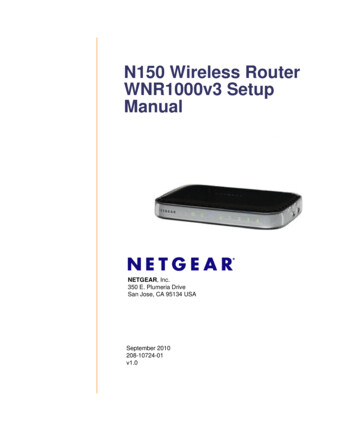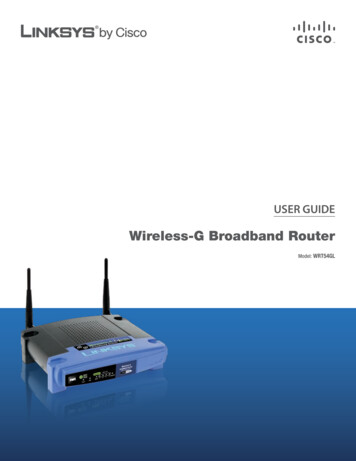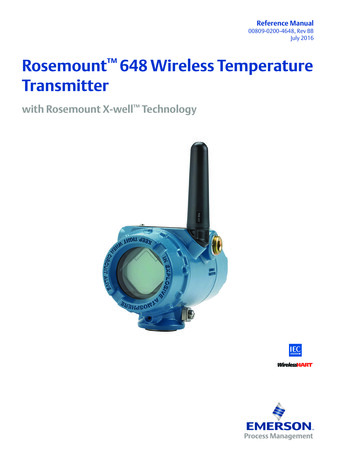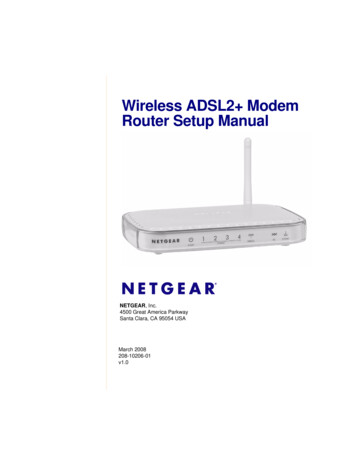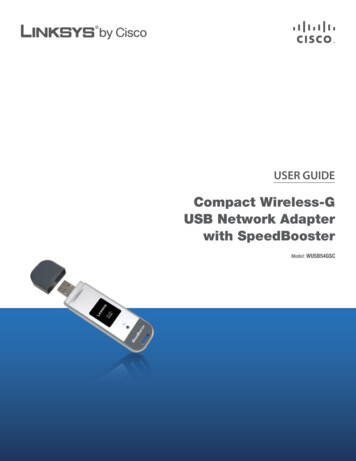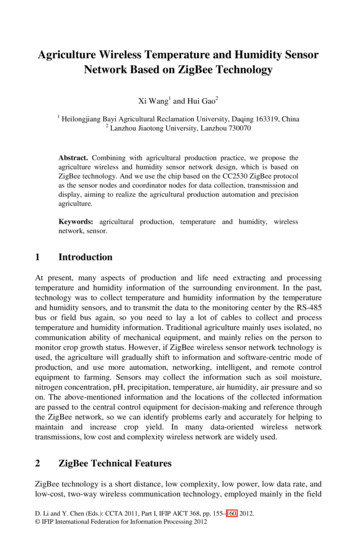
Transcription
Agriculture Wireless Temperature and Humidity SensorNetwork Based on ZigBee TechnologyXi Wang1 and Hui Gao21Heilongjiang Bayi Agricultural Reclamation University, Daqing 163319, China2Lanzhou Jiaotong University, Lanzhou 730070Abstract. Combining with agricultural production practice, we propose theagriculture wireless and humidity sensor network design, which is based onZigBee technology. And we use the chip based on the CC2530 ZigBee protocolas the sensor nodes and coordinator nodes for data collection, transmission anddisplay, aiming to realize the agricultural production automation and precisionagriculture.Keywords: agricultural production, temperature and humidity, wirelessnetwork, sensor.1IntroductionAt present, many aspects of production and life need extracting and processingtemperature and humidity information of the surrounding environment. In the past,technology was to collect temperature and humidity information by the temperatureand humidity sensors, and to transmit the data to the monitoring center by the RS-485bus or field bus again, so you need to lay a lot of cables to collect and processtemperature and humidity information. Traditional agriculture mainly uses isolated, nocommunication ability of mechanical equipment, and mainly relies on the person tomonitor crop growth status. However, if ZigBee wireless sensor network technology isused, the agriculture will gradually shift to information and software-centric mode ofproduction, and use more automation, networking, intelligent, and remote controlequipment to farming. Sensors may collect the information such as soil moisture,nitrogen concentration, pH, precipitation, temperature, air humidity, air pressure and soon. The above-mentioned information and the locations of the collected informationare passed to the central control equipment for decision-making and reference throughthe ZigBee network, so we can identify problems early and accurately for helping tomaintain and increase crop yield. In many data-oriented wireless networktransmissions, low cost and complexity wireless network are widely used.2ZigBee Technical FeaturesZigBee technology is a short distance, low complexity, low power, low data rate, andlow-cost, two-way wireless communication technology, employed mainly in the fieldD. Li and Y. Chen (Eds.): CCTA 2011, Part I, IFIP AICT 368, pp. 155–160, 2012. IFIP International Federation for Information Processing 2012
156X. Wang and H. Gaoof automatic control and remote control, can be embedded in a variety of devices toachieve their automation [1]. For the various existing wireless communicationtechnology, ZigBee technology will be the lowest power consumption and costtechnology.Transfer rate of ZigBee data is low, ranging from 10KB/s to 250KB/s and focusingon low-transmission applications. Under low power standby mode, the two ordinaryNo.5 batteries can last 6 to 24 months. ZigBee data transfer rate is low, and itsprotocol is simple, so it greatly reduces the cost. Network capacity is large toaccommodate 65,000 devices. Delay time is short, usually in the 15ms 30ms.ZigBee provides data integrity checking and authentication capabilities, using AES128 encryption algorithm. Flexible working band, the use of frequency band 2.4GHz,and frequency bands are unlicensed. Such good points as the reliable transmission andthe use of collision avoidance strategies are included while the business that requires afixed bandwidth is reserved specific time slots.3Overall System Design ConceptBased on ZigBee wireless technology, the temperature and humidity sensor networkis composed of three parts: the transmitter, receiver and display system. Transmitter isconstituted by a number of terminal nodes; each node consists of a temperature andhumidity sensor and a ZigBee wireless RF module. Greenhouse temperature andhumidity sensors collect information on temperature and humidity, then temperatureand humidity data is transmitted to the ZigBee wireless RF modules. Correction of thetemperature and humidity data is processed via a chip embedded in ZigBee wirelessRF (radio frequency) module and the data revised will be sent to the receiverthrough ZigBee wireless network. Receiver consists of a ZigBee RF module and anRS232 serial port module. Receiver module that is a network coordinator establishes astar structure of the network. The data of each node is received through ZigBeenetwork and transmitted to the display system via RS232. This is the temperature andhumidity collection and delivery process of a sending node of the system.,Fig. 1. Overall system simulating scheme
Agriculture Wireless Temperature and Humidity Sensor Network4157System Hardware DesignCC2530 meets low-cost and low power requirements of the 2.4GHz ISM band basedon ZigBee. It includes a high-performance 2.4GHz DSSS (direct sequence spreadspectrum) RF transceiver core and a 8051 controller. ZigBee RF front end, memoryand microcontroller are integrated on a single chip. It has 128kB programmable flashmemory and 8kB RAM, including ADC, timers, 32kHz crystal sleep mode timer,power-on reset circuit, power-down monitor circuit and 20 programmable I/O pins,enabling the node miniaturization [2]. CC2530 wireless single chip is characterizedby very low power, standby current consumption of only 0.2μA. Under the run of 32kHz crystal clock, the current consumption is less than 1μA.The temperature and humidity sensor SHT11 integrates several circuits into asingle chip, such as temperature and humidity detection, signal amplificationconditioning, A/D conversion and digital communications interface. Humiditymeasuring range is 0 100% RH, temperature measurement range is -40 123.8 , humidity measuring accuracy is 3.0% RH, temperature measuringaccuracy is 0.4 , and the response time is less than 4s. For digital interfaces,SHT11 provides two-wire digital serial interface SCK and DATA; SCK is the serialclock line for communication between the microprocessors to achievesynchronization. DATA serve as the serial data line, and makes the data transmissionbetween the microprocessors. The chip interface is simple, good at high transmissionreliability, and measurement precision can be adjusted by programming. After themeasurement and communication, low-power mode is automatically transferred.4.1The Hardware Design of the Transmitting NodeTransmitting node is the basic unit of the network composed of digital temperatureand humidity sensor SHT11 module, CC2530 processor module, antenna module,power supply module. It is responsible for acquiring temperature and humidity dataand data preprocessing, and they will be transmitted to ZigBee receiving end.Temperature and humidity sensor module is responsible for collecting and detectingtemperature and humidity data of region. Processor module makes analog-digitalconversion for the collected data signal, and then processes. The processed data isissued by the antenna [3]. The power module mainly supplies power for the processor.Transmitting hardware framework is shown in Fig. 2.Digital temperature andhumidity sensor SHT11CC2530ZigBee wirelesstransceivermodulePowerFig. 2. Transmitting hardware framework
1584.2X. Wang and H. GaoThe Hardware Design of the Receiving NodeReceiver node is composed of a power supply module, a key module, a serial module,a LCD module, LED lights, a CC2530 processor module and an antenna module. Thewireless temperature and humidity sensor network is not an independentcommunication network, which needs transmitting the monitoring temperature andhumidity data to the host computer and displaying them. LED indicator lights areused to display the receiving node network state information (e.g. whether thenetwork is built successfully); LCD module is an interface of the user and sensornetwork to display the function menu, and the user selects them by pressing buttons.CC2530 is a data-receiving mode. When data is received, RF receiving signals areamplified by the low noise amplifier before they are overturned into the frequencymixer. By mixing frequency, IF (intermediate frequency) signal is produced. In IFprocessing stage, before the signal into the demodulator is amplified and filtered, thedata of demodulation is put into the shift register, and then into RFBUF. After thetemperature and humidity data in RFBUF are removed by MCU, they will be put intothe data buffer register SBUF of UART, and be transmitted to the host computerthrough RS232 serial module5System Software DesignThe system using development environment is IAR7.51A while the using protocolstack is Z-STACK of TI. The system connecting the receiving end to PC via the serialFig. 3. Transmitter and receiver software flowchart
Agriculture Wireless Temperature and Humidity Sensor Network159port RS232 must know the network address of each sensor node, requiring that thenetwork address is sent to the receiver after each sensor device joins the network. Thereceiver receiving the network address of the sensor establishes address table to storeso that the user collects data of each sensor according to address table when collectingdata [4]. Transmitter and receiver software flowchart is shown in Fig. 3.6Construction of Wireless Sensor Networks Based on ZigBeeThe FFD (full functional device) must lead as the network coordinator to establish anetwork, then the other FFD or RFD join the network, but the RFD (reduce functionaldevice)can only link to FFD. According to the device function in the network,programs are designed beforehand for the device. The coordinator function is tosearch by scanning and scanning 16 channels set the applicable optimum channel tostart a network. The device can form a network (coordinator) in the free channel, orconnect to an existed network. Router function is to search by scanning to find anactive channel and connect it, then allow connecting other installations. The functionof terminal devices is always trying to connect to an existed network. Those terminaldevices search other devices that can provide complete search service in the networkallowing any network device to initialize the service search [5], and can bind otherdevices that will provide full service, offering commands and control features for thespecified set of conforming devices.Central control center is connected to a number of the sending end through thenetwork connection. Wireless information transmission between the receiver andtransmitter is achieved via Zig Bee technology. The sender is responsible fordetecting and processing data and sends it to the receiver. The control center gets thecollected relevant information through the network. Multiple senders are distributedin the sensor network, so polling scan is put to the upload data from different ID sinknodes and data of sink nodes can be orderly, completely transmitted after beingtreated through MCU.7ConclusionsThis paper proposes a wireless temperature and humidity sensor network systembased on ZigBee technology, and networking ways are of flexibility, adaptability.Through the practical application in the laboratories and its surrounding offices, thissystem is proved to be very practical. In practical applications, terminal devicenumber is determined by achieving goal demands. The system can be applied toagricultural production, as well as in more areas of production and life, solvingmonitor environmental temperature and humidity problems in the areas of high costand inconvenience arrival of wired network cabling, abominable environment. ZigBeenetworking ways typical of simple and low power consumption make the temperatureand humidity information in real-time delivery reduce system costs, save energy, andconserve resources, and its low cost for the promotion in industry providesconvenience. With ZigBee chips at lower prices, the new temperature and humiditymonitoring system will also have a broad application prospect.
160X. Wang and H. GaoReferences1. Zhai, L., Liu, S., Hu, Y.: ZigBee Technology and Application, pp. 313–347. BeijingAeronautics and Astronautics Press (2007)2. Chipcon semiconductor. CC2530 Data Sheet 1.02, http://www.chipcon.com3. Liu, Y., Wang, C., Yu, C.: Research on ZigBee wireless Sensors Network Based onModBus Protocol. Information Technology and Applications, 487–491 (May 2009)4. Chipcon semiconductor. Chipcon IAR User Manual, http://www.chipcon.com5. Song, J.: Wireless sensor network node design and implementation. Jilin University Schoolof Instrument Science and Electrical Engineering
Based on ZigBee wireless technology, the temperature and humidity sensor network is composed of three parts: the transmitter, receiver and display system. Transmitter is constituted by a number of terminal nodes; each node consists of a temperature and humidity sensor and a ZigBee wireless RF module. Greenhouse temperature and





